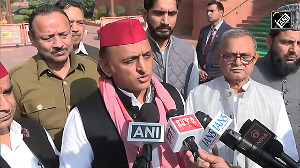During the best of times, any finance minister has difficulties in meeting competing demands in formulating the Budget. This year, the finance minister has had to face three additional constraints in his budgetary exercise.
The first is that the Budget has been formulated in the background of rising crude prices, the tsunami disaster, and already pressed and persisting fiscal imbalances.
The second is the additional amount of Rs 26,000 crore (Rs 260 billion) that the Centre has to transfer to the states consequent to the Twelfth Finance Commission's recommendations. The third is the compulsions of coalition politics and the allocations to be made to meet the demands of the Common Minimum Programme.
Between the second and third compulsions, an additional expenditure of over Rs 51,000 crore (Rs 510 billion) had to be allocated. Despite these, the Budget for 2005-06 has been crafted to evoke positive vibes from virtually all sections of society. However, as the various provisions of the Finance Bill sink in, a more realistic assessment is unavoidable.
There is much that is commendable in the Budget and the captains of industry are rightfully euphoric about them. The increased allocation to investment in infrastructure, the signal given to liberalising the inflow of foreign direct investment, and the reduction in the "peak" rate of customs duty are some of the measures that are likely to increase competitiveness and enhance growth prospects of the Indian economy.
Similarly, virtually all income tax payers would be happy to have tax liability reduced, and the proposed rationalisation in savings incentives is welcome. There would, however, be questions on the abolition of standard deduction for the salaried tax payers. The alignment of corporate tax rates with marginal personal income tax rates by rationalising depreciation allowance is also a welcome measure.
Similarly, fixing the threshold for the service tax is necessary to remove harassment to small taxpayers. With 80 per cent taxpayers out of the net, the tax administration can focus on the important 20 per cent.
However, fiscal fundamentalists would certainly rue the missed opportunity to undertake revenue-positive reforms in the tax structure. Much could have been done to expand the tax base of excise duties by reducing the scope of exemption to small-scale industries.
Rather than providing incentives for the small-scale sector to grow into medium- and large-scale industries, the proposed increase in the turnover limit for exemption and capital subsidy provides additional comfort for them to remain small.
There is also considerable scope for rationalising the excise duty rates and unifying them into a single CENVAT rate.
Similarly, the opportunity to expand the base of the service tax on all services with a small exemption list and a negative list and eventually have a road map towards a manufacturing stage value-added tax on goods and services has been missed yet again.
Also, a minimum tax on all exempted items under the customs duties could have brought in revenue while reducing the divergence in the nominal duty rates.
The matter of serious concern is the "pause" button the finance minister has chosen to press for fulfilling the obligations under the FRBM Act.
This clearly gives a wrong signal and widens the credibility gap. To enforce fiscal discipline, the Twelfth Finance Commission has recommended that the states too should enact fiscal responsibility laws to phase out their revenue deficits and limit fiscal deficits. he states will surely take a cue from the Centre's "pause", to the detriment of fiscal discipline in the country. In terms of both the inability to undertake fiscal adjustment and giving a wrong signal, this is retrograde.
There are also doubts as to whether even the pause that is claimed is not a slippage. In 2004-05, with the expanded nominal GDP, the Budget estimate of Rs 76,171 crore (Rs 761.71 billion) equals 2.4 per cent of GDP and this has escalated to 2.7 per cent of GDP. This is due almost entirely to the shortfall in revenues, that too in excise duties and the corporation tax.
In 2005-06, the Budget estimate of revenue shows a growth rate of almost 21 per cent in the aggregate. Some would certainly consider this to be optimistic, particularly because the growth rate of about 21 per cent in excise duties and 33 per cent in the corporation tax and over 30 per cent in the personal income tax are out of line with the trend growth rates.
The only way this can happen is by accelerating administrative reform, including operationalising the Tax Information Network and the online tax accounting system.
At the same time, on the expenditure front, it seems that the fiscal deficit target is kept at the level of 2004-05 by cutting capital expenditure and this has come about by removing central loan assistance to state plans following the recommendation of the Finance Commission.
Thus, the fiscal deficit of the Centre has been contained actually by allowing the states to access their loans from the market rather than central borrowing. In other words, on a comparable basis, the Centre's fiscal deficit is actually higher by about 0.7 per cent of GDP.
To the above, we need to add an additional Rs 10,000 crore (Rs 100 billion) loan to be contracted through the special purpose vehicle. There has been considerable discussion on this issue and those who adopted the cautious line, the "fiscal fundamentalists", have warned about the adverse consequences of using the foreign exchange reserves for funding infrastructure.
Perhaps, the more desirable option would have been to liberalise the external sector, including the capital account, to cope with surging capital inflows, with of course, adequate safeguards. Surely, if the central government itself tries to find escape routes from the FRA targets, it will be difficult to enforce fiscal discipline in the country.
Indeed, the finance minister's compulsions are too formidable and he has tried to balance the competing demands -- among others, the spending of Rs 25,000 crore (Rs 250 billion) on CMP sectors, which predominantly are the states' domain.
These compulsions will continue in the years to come. The success in fiscal adjustment will depend on the way the finance minister balances them.
While the increased allocations to education, healthcare, and employment guarantee programmes will surely bring satisfaction to many well-meaning people, it is important to simultaneously institute measures to improve the delivery systems. Surely, that is not an agenda for the finance minister.
The author is Director, National Institute of Public Finance and Policy, New Delhi. The views are personal





